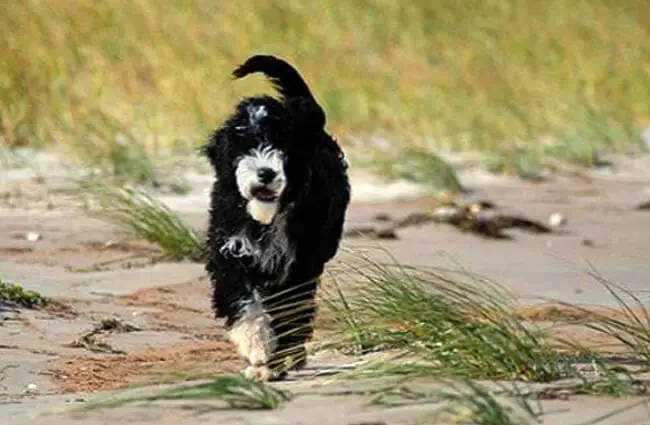A Deep Dive into the Portuguese Water Dog
The Portuguese Water Dog, often affectionately called a “Cão de Água,” is a breed steeped in history and brimming with character. Originating from the rugged coast of Portugal, these intelligent and energetic dogs were indispensable partners to fishermen for centuries. Today, they are cherished companions known for their loyalty, trainability, and distinctive waterproof coat. This exploration delves into all facets of the breed, from its working origins to its suitability as a family pet.

Historical Roots and Working Heritage
For generations, Portuguese Water Dogs were the stalwart companions of fishermen along the Algarve coast. Their tasks were varied and vital. They acted as messengers between boats and shore, retrieved lost tackle and broken nets, and even herded fish into nets. Their athleticism in the water was legendary. The breed’s semi-retrieving style, rather than a direct retrieve, was particularly suited to the challenging coastal conditions. As fishing practices evolved in the 20th century, the breed faced a decline, nearly reaching extinction. Dedicated breeders in Portugal and the United States worked tirelessly to preserve this remarkable working dog, ultimately saving it from disappearing altogether. The breed gained further prominence when President Barack Obama chose a Portuguese Water Dog named Bo for his family, offering a high‑profile boost to the breed’s popularity.
Physical Characteristics and Appearance
Portuguese Water Dogs are medium-sized, powerfully built dogs. Males typically stand between 20 and 23 inches tall at the shoulder and weigh between 42 and 60 pounds. Females are slightly smaller, ranging from 17 to 21 inches tall and weighing between 35 and 50 pounds. They have a distinctive, athletic build reflecting their working past.
Their coat is perhaps their most notable feature. It is waterproof, dense, and either curly or wavy. Traditionally, there were two coat types: curly and wavy. Breeders have maintained both, though the curly coat is considered more hypoallergenic. The coat comes in black, white, or brown, and often features white markings. Historically, the coat was often clipped in a “lion clip,” shaved on the rear half of the body and left long on the front, to ease movement while swimming and working. This practice is less common now, but it is still seen in some working dog circles.

Temperament and Behavior
Portuguese Water Dogs are known for their intelligence, energy, and affectionate nature. They are highly trainable and eager to please, making them excellent candidates for obedience training, agility, and other dog sports. However, their intelligence also means they can be mischievous if not given enough mental stimulation. Early socialization is crucial to ensure they are well‑adjusted and confident around strangers and other animals.
These dogs are typically energetic and playful, requiring a significant amount of exercise to stay happy and healthy. They enjoy swimming, running, and playing fetch, and thrive in active households. They form strong bonds with their families and can be protective of their loved ones. While generally good with children, supervision is always recommended, particularly with very young children, due to their energetic nature. They have a natural herding instinct, which may manifest as nipping at heels, so early training can help manage this behavior.

Caring for a Portuguese Water Dog
Owning a Portuguese Water Dog is a rewarding experience, but it requires commitment and understanding of their specific needs. Here’s a breakdown of essential care requirements:
- Exercise: A minimum of 60-90 minutes of vigorous exercise daily is crucial. This can include running, swimming, hiking, or engaging in dog sports.
- Grooming: Their waterproof coat requires regular grooming to prevent matting and tangles. Brushing several times a week is essential, and professional grooming may be needed every few months.
- Training: Early socialization and consistent training are vital to ensure a well‑behaved and confident dog. Positive reinforcement methods work best.
- Diet: A high‑quality dog food formulated for medium to large breeds is recommended. Adjust the portion size based on their activity level and age.
- Health: Portuguese Water Dogs are generally healthy, but they are prone to certain genetic conditions, including hip dysplasia, progressive retinal atrophy, and dilated cardiomyopathy. Regular veterinary checkups and genetic testing can help identify and manage these conditions.

Suitability as a Family Pet
Portuguese Water Dogs can make wonderful family pets for the right households. They are affectionate, playful, and intelligent. However, they are not a good fit for sedentary individuals or families who cannot provide them with the exercise and mental stimulation they need. They thrive in active households where they can participate in outdoor activities and engage in training.
Due to their energetic nature and potential for mischief, they require consistent training and supervision, especially around young children. They are also sensitive dogs who respond best to positive reinforcement methods. With proper socialization and training, they can become loyal and loving companions for many years.

Beyond the Basics: Nuances of the Breed
For prospective owners seeking a deeper understanding, several nuances characterize the Portuguese Water Dog. Their intelligence, while a strength, can also lead to stubbornness. They excel with puzzle toys and advanced obedience training, but require consistent challenges to prevent boredom. They are also known for their soft mouths, they enjoy carrying things in their mouths without applying excessive pressure, a trait useful in their historical role of retrieving tackle.
Furthermore, their coat requires specialized care. Beyond regular brushing, stripping – removing dead outer coat by hand – can promote healthy coat growth. Many owners opt for professional grooming to maintain the coat’s texture and prevent matting.

Conclusion
The Portuguese Water Dog is a remarkable breed with a rich history and a vibrant personality. They are intelligent, energetic, and affectionate companions who thrive in active households. While they require commitment and consistent care, the rewards of owning a Portuguese Water Dog are immeasurable. For those willing to meet their needs, this breed offers a lifetime of loyalty, companionship, and playful energy.






![Red Angus Closeup of a beautiful Red Angus cowPhoto by: U.S. Department of Agriculture [pubic domain]https://creativecommons.org/licenses/by/2.0/](https://animals.net/wp-content/uploads/2020/03/Red-Angus-4-100x75.jpg)

